A) V.crabro (European hornet), vs. B) Vespa Orientalis (Oriental Hornet). Photo credit: Adrian Ruicanescu
The Oriental hornet is on the rise.Vespa orientalis) has been recorded across Andalucía, with confirmed reports increasing by more than 30 percent since the species was first detected in the Campo de Gibraltar in 2018. According to data from the environmental office in Málaga, nest removals grew from 28 in 2023 to over 380 by September 2024, indicating rapid expansion across several provinces.
This hornet, native to arid regions of North Africa and the Middle East, has now established itself in Cádiz, Málaga, Seville, Córdoba, Huelva, and Jaén, prompting concern among environmental authorities, agricultural unions, and beekeepers.
Luis Morales, of COAG-A a regional agricultural organization, said that “we’re experiencing serious ecological pressures on honeybee colonies and fruit growers.” “This is a non-native species, and has no natural enemies here.”
Identification: Vespa orientalis vs Vespa crabro
Officials urge the public to distinguish correctly between the Oriental hornet and the (Vespa orientalisIt is an invasive pest and can be harmful.Vespa crabroIt is a native of Europe that has a positive impact on the environment. These two species are easily confused, especially due to the similar sizes and colours.
The following features can help identify the item:
Oriental Hornet (Vespa orientalis)
- Body is a reddish-brown color with a Yellow band Second abdominal segment
- Face is a whole bright yellow
- Slightly smaller (20–30 mm)
- Nests are often found in Compost heaps and wallsOr Underground Cavities
- Active during Hot, sunny hours
- Near food sources, aggressive behavior is common Honeybees are known to attack honeybee colonies
- Invasive species In Spain
European Hornet (Vespa crabro)
- Brownish thorax and brownish limbs. Yellow and brown striped abdomen
- A reddish yellow head with a Pale yellow face
- Slightly larger (25–35 mm)
- Nests Wall cavities, tree hollowsOr attics
- Then, non-aggressive Unscathed
- Feeds for flies, pest insects and other flying insects Bees are not targeted
- Native Consideration Ecosystems benefit from the use of a variety of plants
“The two species are similar at a glance, but their behaviour and ecological impact are very different,” said Dr. María Sánchez, entomologist at the University of Granada.
Yellow jacket wasps are also known as yellow jacket beetles (Vespula spp.They are smaller and have a sharper contrast between black and yellow, and a more aggressive behavior near food or waste. Neither are commonly confused with each other. Vespa crabro You can also find out more about Vespa orientalis By trained observers
Ecological Impact Spread
The oriental hornet is a major threat to honey bee colonies. They ambush foragers often at the entrances to hives. Also, it damages soft fruits such as grapes and plums. The rapid spread of the disease is aided in part by urbanization and climate conditions.
“These hornets are thriving in Andalusian heat and adapting well to man-made environments,” Dr. Sánchez explained. We believe that climate change, human infrastructure and the lack of natural predators are fueling their growth.
Public Guidance
It is important that the public does not disturb or approach nests which can be hidden in garden wall, compost heaps, and other cavities. The Oriental hornet is aggressive and can sting many times.
If you suspect a nest or hornet of oriental origin, then:
- Remove the syringes only with a syringe wrench.
- If possible, take a photo from a distance that is safe.
- Report the sightings to the local authorities
- Installing protective mesh and carefully monitoring hives is something that beekeepers should seriously consider.
Reporting Sightings
Confirmed or suspect sightings Vespa orientalis Should be reported via the following channels:
- Andalusian Environmental Hotline: 900 900 051
- Red de Alerta de Especies Invasoras:
A Call to Public Awareness
Experts stress the importance of accurate identification and early reporting to limit its impact.
“People often kill the wrong species out of fear,” said Dr. Sánchez. “But Vespa crabroThe European hornet is a part of our eco-system and helps to control pests. The oriental hornet is the real threat — and public awareness is our first line of defence.”
 Costa News Spain Breaking News | English News in Spain.
Costa News Spain Breaking News | English News in Spain.





